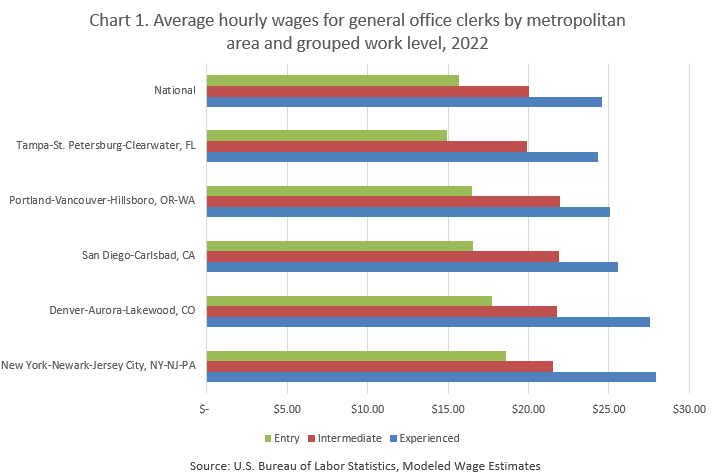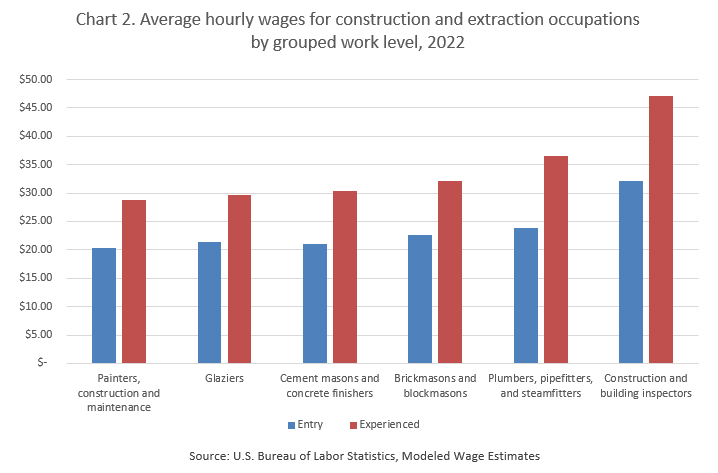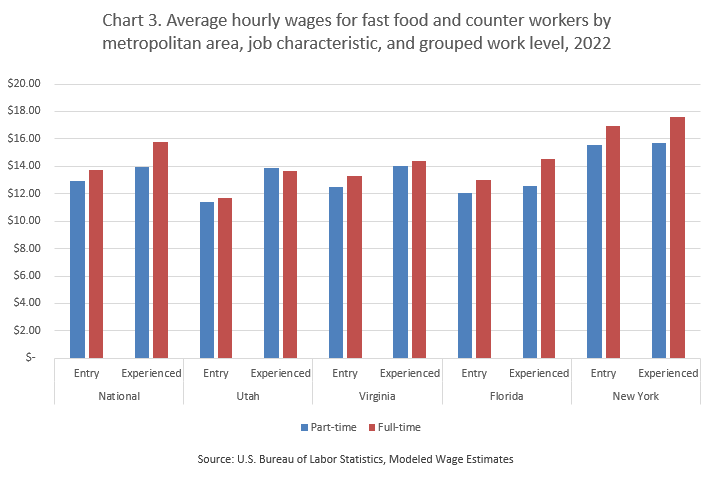An official website of the United States government
 United States Department of Labor
United States Department of Labor
The Modeled Wage Estimates (MWE) provide annual estimates of average hourly wages for occupations by job characteristics and within a given geographical location. Job characteristics refer to the attributes of workers within an occupation and include worker bargaining status (union and nonunion), work status (part-time and full-time), basis of pay (incentive-based or time-based), and work level (entry, intermediate, experienced, 1–15 and unable to be leveled).
MWE is produced by leveraging the strength and breadth of the Occupational Employment and Wage Statistics (OEWS) and National Compensation Survey (NCS) programs to provide more details on occupational wages than either program provides individually. The occupational and geographic wage data come from the OEWS and the job characteristics, which include bargaining status (union and nonunion), work status (part-time and full-time), basis of pay (incentive-based and time-based), and work level wage data, come from the NCS.
Work levels are calculated based on:
Knowledge: amount needed to perform a job at different levels
Job controls and complexity: amount and type of direction received, the complexity of work and the nature of the work within a job
Contacts: nature and purpose contacts within a job but outside the supervisory chain
Physical environment: nature of risk, and amount of physical demand with a job
Levels are determined using the National Compensation Survey: Guide for Evaluating Your Firm’s Jobs and Pay to assign points to each of the four factors. Work levels are based on total points.
Among nature and purpose of contacts, lower points are assigned to jobs where employees’ contacts are primarily with coworkers inside the organizational unit or visitors to the work area (such as the public), and straightforward information is exchanged. Higher points are assigned to jobs where employees’ contacts are somewhat unstructured and primarily with technical individuals (such as scientists and engineers) as well as influential individuals inside and outside of the employing organization (such as elected officials, managers, media representatives, judges, or attorneys), and the nature of the contacts includes defending, negotiating, or resolving long-range issues and problems.
Among job controls and complexity, lower points are assigned to jobs where employees do not deviate from established procedures or direction provided by the supervisor. Tasks are clearly identified and related with little to no choice necessary to perform them. Work consists of simple and repetitive tasks, and the work has minimal impact outside the immediate organizational unit. Higher points are assigned to jobs where employees work with only administrative and policy direction and must define objectives, plan work, and develop new methods that influence workplace activities.
Among physical environment, lower points are assigned to jobs with low risk that are primarily sedentary and where workers may also walk, stand, or carry light objects. Higher points are assigned to jobs that that require lifting more than 50 pounds or involve climbing or running. These jobs may also include working in extreme temperatures, having a likelihood of physical attack, or potential exposure to smoke or fire.
Job controls and complexity, contacts (nature and purpose) and physical environment have the same grading criteria across occupations, however, knowledge points are assigned based on occupation family groups. For example, the guide for assessing the knowledge score of business administration fields, such as human resources, budgeting, contracting, business analysis, marketing, and real estate and building management, is different than for information technology occupations, such as systems analysts, computer programmers, and systems and database administrators.
Starting in the 2021 publication, MWE includes grouped work levels among entry, intermediate and experienced levels. Grouped levels assist in broad level comparisons and may help researchers, human resources professionals, jobseekers, and other data users better understand how grouped work level pay varies amongst occupation, job characteristic and locality. Grouped work level estimates were created from meaningful group level distinctions within an occupation, consisting of either two groups for entry and experienced levels or three groups for entry, intermediate and experienced levels. For example, occupations like food preparation workers and nursing assistants were grouped into entry and experienced levels and occupations such as accountants and auditors were grouped into entry, intermediate and experienced levels.
In 2022, general office clerks wages were $15.66 at the entry level, $20.04 at the intermediate level and $24.56 at the experienced level. In Tampa-St. Petersburg-Clearwater, FL general office clerks’ wages were $14.91 at the entry level, $19.92 at the intermediate level and $24.30 at the experienced level. In New York-Newark-Jersey City, NY-NJ-PA, general office clerks’ wages were $18.59 at the entry level, $21.52 at the intermediate level and $27.91 at the experienced level (See Chart 1).

| Area | Entry | Intermediate | Experienced |
|---|---|---|---|
|
National |
$15.66 | $20.04 | $24.56 |
|
Tampa-St. Petersburg-Clearwater, FL |
$14.91 | $19.92 | $24.30 |
|
Portland-Vancouver-Hillsboro, OR-WA |
$16.47 | $21.94 | $25.09 |
|
San Diego-Carlsbad, CA |
$16.57 | $21.92 | $25.54 |
|
Denver-Aurora-Lakewood, CO |
$17.73 | $21.79 | $27.58 |
|
New York-Newark-Jersey City, NY-NJ-PA |
$18.59 | $21.52 | $27.91 |
|
Source: U.S. Bureau of Labor Statistics, Modeled Wage Estimates |
|||
Among construction and extraction occupations in 2022, painters, construction and maintenance workers’ wages were $20.37 at the entry level and $28.69 at the experienced level. Glaziers’ wages were $21.31 at the entry level and $29.65 at the experienced level. Cement masons and concrete finishers’ wages were $21.09 at the entry level and $30.28 at the experienced level. Brickmasons and blockmasons’ wages were $22.58 at the entry level and $32.20 at the experienced level. Plumbers, pipefitters and steamfitters’ wages were $23.81 at the entry level and $36.59 at the experienced level. Construction and building inspectors’ wages were $32.06 at the entry level and $47.11 at the experienced level (See Chart 2).

| Occupation | Entry | Experienced |
|---|---|---|
|
Painters, construction and maintenance |
$20.37 | $28.69 |
|
Glaziers |
$21.31 | $29.65 |
|
Cement masons and concrete finishers |
$21.09 | $30.28 |
|
Brickmasons and blockmasons |
$22.58 | $32.20 |
|
Plumbers, pipefitters, and steamfitters |
$23.81 | $36.59 |
|
Construction and building inspectors |
$32.06 | $47.11 |
|
Source: U.S. Bureau of Labor Statistics, Modeled Wage Estimates |
||
In 2022, fast food and counter workers’ wages in the U.S. among the entry level were $12.90 for part-time and $13.76 for full-time and wages among the experienced level were $13.95 for part-time and $15.75 for full-time. In Utah, entry level wages were $11.43 for part-time and $11.70 for full-time workers and experienced level wages were $13.86 for part-time and $13.68 for full-time workers. In New York, entry level wages for fast food and counter workers were $15.59 for part-time and $16.92 for full-time workers and experienced level wages were $15.72 for part-time and $17.62 for full-time (See Chart 3).

| State | Group level | Part-time | Full-time |
|---|---|---|---|
|
National |
Entry | $12.90 | $13.76 |
| Experienced | $13.95 | $15.75 | |
|
Utah |
Entry | $11.43 | $11.70 |
| Experienced | $13.86 | $13.68 | |
|
Virginia |
Entry | $12.51 | $13.29 |
| Experienced | $13.99 | $14.38 | |
|
Florida |
Entry | $12.05 | $12.98 |
| Experienced | $12.54 | $14.53 | |
|
New York |
Entry | $15.59 | $16.92 |
| Experienced | $15.72 | $17.62 | |
|
Source: U.S. Bureau of Labor Statistics, Modeled Wage Estimates |
|||
Comparisons of hourly wage estimates by location, work levels, hours, and other factors
Revisiting the dilemma of review for modeled wage estimates by job characteristic
Wage estimates by job characteristic: NCS and OES program data
Last Modified Date: August 24, 2023